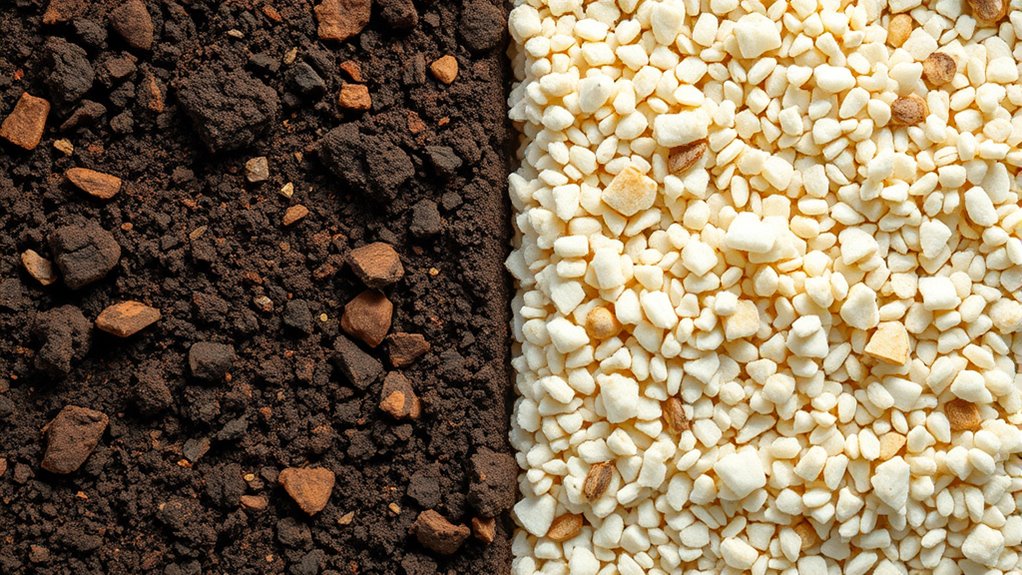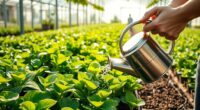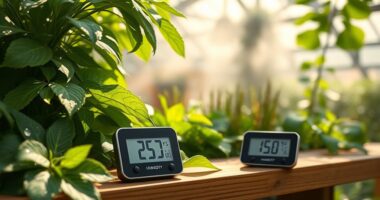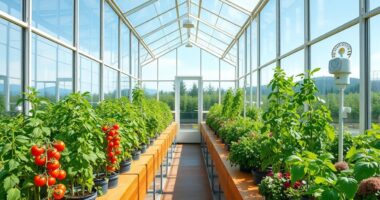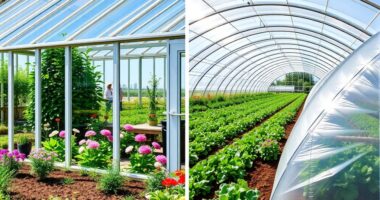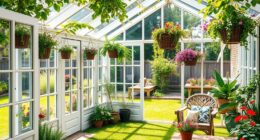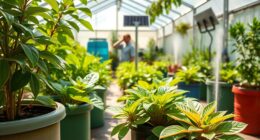When choosing between soil and soilless mixes for your greenhouse, consider your plants’ needs and your maintenance style. Soil offers natural nutrients and microbial activity, but quality varies and drainage can be an issue. Soilless mixes provide better control over drainage, aeration, and nutrients, often leading to faster growth. Adding organic amendments to either option can boost microbial life and fertility. Continue exploring to discover which mix suits your greenhouse environment best.
Key Takeaways
- Soil offers natural nutrients and microbial activity but may require amendments for drainage and fertility.
- Soilless mixes provide optimal drainage, aeration, and precise nutrient control, ideal for hydroponics.
- Choose soil if you prefer organic, soil-based growing with minimal synthetic inputs; opt for soilless for faster, controlled growth.
- Drainage and moisture management are critical; soil may need amendments to prevent waterlogging, while soilless mixes facilitate better water control.
- Consider plant needs, maintenance, and environment when selecting: soil for organic richness, soilless for precision and speed.
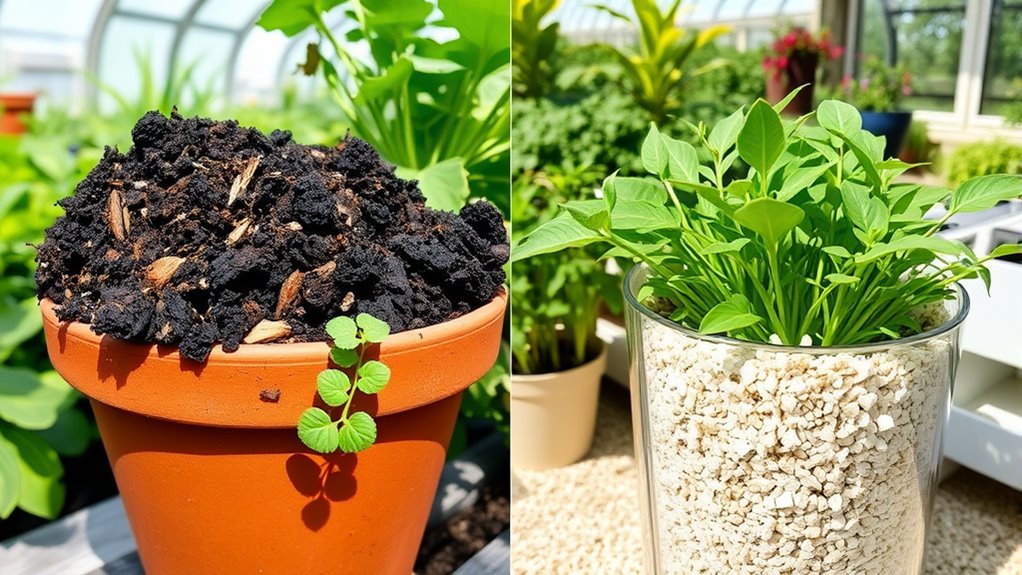
Have you ever wondered whether growing plants in soil or soilless mediums is better? The choice depends on your specific goals, the plants you want to grow, and the environment you’re working with. When considering soil, you’re looking at a natural, organic environment that can support a wide variety of plants. However, the quality of soil can vary greatly, so it’s essential to enhance it with organic amendments. These amendments—like compost, aged manure, or organic matter—improve soil fertility, provide essential nutrients, and boost microbial activity. They also help create a more balanced environment for roots to thrive. But even with rich organic amendments, soil can present challenges, particularly with drainage. Poor drainage solutions in traditional soil can lead to waterlogged roots, which cause root rot and hinder growth. If your soil retains too much water, you’ll need to work on improving drainage, perhaps by adding sand or perlite, or by elevating beds to prevent excess moisture from stagnating around plant roots. Proper drainage is crucial for maintaining healthy root systems and preventing disease. Additionally, understanding the importance of soil structure can help optimize growing conditions and improve plant health.
On the other hand, soilless mediums, such as peat-based mixes, coconut coir, or rockwool, are engineered to provide *ideal* conditions for plant growth. These mixes are designed for excellent drainage and aeration, which reduces the risk of root diseases. Since they are inert, they don’t contain pests or weed seeds, making them a low-maintenance option. As a gardener, you have the advantage of controlling the nutrients directly, often through liquid feeds or fertilizers tailored to specific plants. This precise control means you can adjust feeding schedules and nutrient levels more easily than with soil, leading to faster growth and higher yields. The improved drainage in soilless mixes prevents waterlogging, ensuring roots receive enough oxygen, which is critical for healthy development. Additionally, many soilless mediums are compatible with hydroponic systems, allowing for innovative growing techniques that maximize space and efficiency.
Moreover, some soilless mixes mimic the natural environment of certain plants, encouraging healthier root systems and more vigorous growth. However, soilless mixes aren’t self-sustaining; they require regular fertilization because they lack the organic matter that naturally replenishes nutrients in soil. If you prefer a more organic approach, you can incorporate organic amendments into your soilless mix, blending the best of both worlds. This way, you can enhance microbial activity and nutrient availability while maintaining the excellent drainage properties. Ultimately, the decision hinges on your plants’ needs, your gardening style, and how much effort you’re willing to invest in maintaining your growing medium. Both soil and soilless mixes offer unique advantages, but understanding their differences—especially regarding organic amendments and drainage solutions—helps you choose the *most suitable* fit for your greenhouse.
Frequently Asked Questions
How Often Should I Change My Greenhouse Potting Mix?
You should change your greenhouse potting mix every 1-2 years to maintain ideal pH adjustment and nutrient replenishment. Over time, the mix can become compacted and depleted, affecting plant health. Regularly check for signs like poor growth or disease. When you notice these issues, it’s time to refresh the mix, ensuring your plants get the right balance of nutrients and pH levels for healthy growth.
Can I Mix Soil and Soilless Media?
Did you know that blending media can improve plant growth by up to 30%? Yes, you can mix soil and soilless media for your greenhouse. This media blending allows you to customize your soil amendments, enhancing drainage, aeration, and nutrient retention. Just guarantee you balance the components carefully, avoiding overly dense mixes that could hinder root health. Mixing provides a versatile approach to creating an ideal environment for your plants.
What Are Signs My Potting Mix Needs Replacement?
You’ll know your potting mix needs replacing when you notice poor soil health, like compacted or moldy soil, or if your plants show signs of nutrient imbalance, such as yellowing leaves or stunted growth. Over time, nutrients deplete and the soil’s structure deteriorates. Regularly check your mix and replace it when these signs appear to guarantee your plants get the proper nutrient balance and a healthy growing environment.
Is Organic Matter Necessary in Soilless Mixes?
Imagine your plants thriving in a vibrant, airy greenhouse. Organic matter in soilless mixes isn’t always necessary, but organic amendments can boost nutrient balance and improve soil structure. They add crucial nutrients and beneficial microbes, creating a healthy environment for root growth. Without organic matter, your plants might lack essential nutrients, leading to poor health. So, including organic amendments ensures your soilless mix nurtures robust, flourishing plants every time.
How Does Potting Mix Affect Plant Disease Resistance?
Your potting mix markedly impacts plant disease resistance. A well-balanced mix with proper drainage reduces pathogen buildup, lowering disease risk. It also guarantees ideal nutrient availability, strengthening your plants’ immune system. Avoid overly compacted or poor-quality mixes, as they create environments for pathogens to thrive. Regularly replacing or sterilizing your mix helps prevent disease spread, so you keep your plants healthy and resilient against infections.
Conclusion
Choosing between soil and soilless mixes depends on your specific greenhouse needs. Did you know that soilless mixes can boost plant growth rates by up to 30% compared to traditional soil? By understanding the benefits and limitations of each, you can make an informed decision that guarantees healthy, vigorous plants. Whether you prefer the natural feel of soil or the control of soilless options, selecting the right mix will help your greenhouse thrive.
